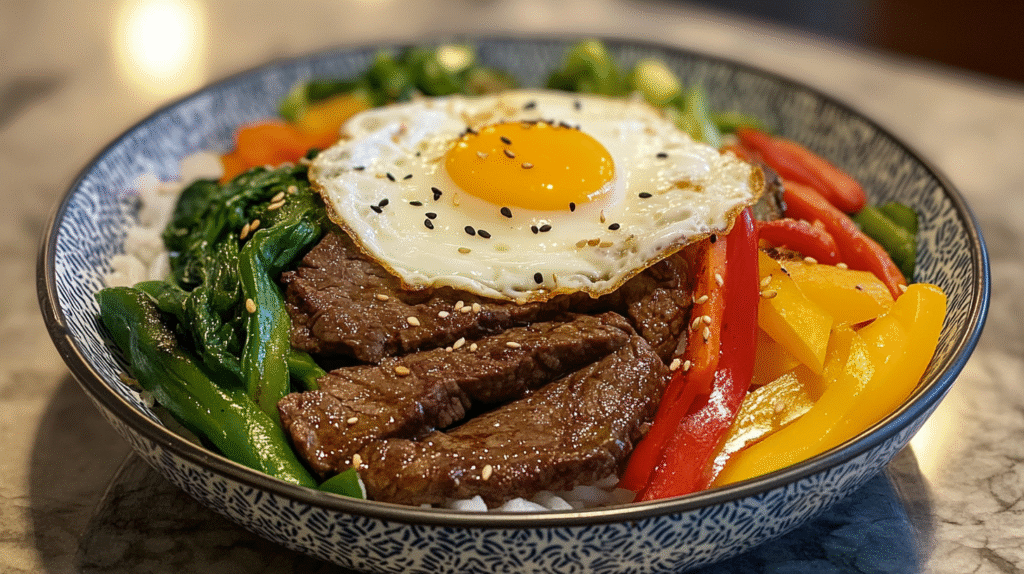Korean cuisine is a vibrant and diverse culinary tradition that has captivated food lovers worldwide. From spicy and savory flavors to rich umami tastes, Korean food offers a unique experience that reflects the country’s history, culture, and way of life. Whether it’s traditional dishes passed down through generations or modern street foods gaining global fame, Korean cuisine has something for everyone.
But what is Korea’s most popular food? While there are countless beloved dishes, a few stand out as national favorites. In this article, we will explore the most iconic Korean foods, their history, and why they hold a special place in the hearts (and stomachs) of Koreans and international food lovers alike.
Let’s dive into the delicious world of Korean food!
Table of Contents
The Rich Culinary Heritage of Korea
Korean cuisine has evolved over thousands of years, influenced by historical events, trade, and regional ingredients. The country’s food culture is deeply connected to its geography, with mountains, rivers, and coastal areas playing a significant role in shaping traditional dishes.
Historically, Korean food has been influenced by Confucianism and Buddhism, which emphasized balance in meals. The idea of “banchan” (small side dishes) and harmony in flavors stems from these philosophies. Korean cuisine is also known for its fermentation techniques, which enhance both flavor and health benefits, as seen in kimchi, doenjang (soybean paste), and ganjang (soy sauce).
The introduction of chili peppers in the 16th century revolutionized Korean food, leading to the creation of the bold, spicy flavors that define many popular dishes today. Now, Korean cuisine is a global sensation, loved for its deep flavors, healthy ingredients, and interactive dining experiences like Korean BBQ.
What is Korea’s Most Popular Food?

Korean food is incredibly diverse, but a few dishes stand out as the most iconic. Below are Korea’s most beloved and widely consumed dishes.
Kimchi – Korea’s National Dish
If there’s one dish that represents Korea, it’s kimchi. This fermented vegetable dish, usually made with napa cabbage and radish, is the backbone of Korean cuisine. Every Korean household has its own kimchi recipe, passed down through generations.
Why is kimchi so popular?
- It is a staple side dish served with almost every Korean meal.
- Kimchi is packed with probiotics, promoting gut health.
- It can be used in a variety of dishes, from kimchi stew (kimchi jjigae) to kimchi fried rice.
- The fermentation process gives it a deep, umami-rich taste that improves over time.
There are over 200 types of kimchi, including kkakdugi (cubed radish kimchi), baek kimchi (white kimchi, non-spicy), and yeolmu kimchi (young radish kimchi), each offering different flavors and textures.
Bibimbap – The Ultimate Comfort Food
Bibimbap is a colorful, nutritious, and well-balanced dish that consists of:
- Steamed rice
- Sautéed and seasoned vegetables
- Sliced meat (usually beef or chicken)
- A fried egg on top
- Gochujang (red chili paste) or soy sauce for seasoning
Mixing everything together creates a delicious explosion of flavors and textures. Some popular regional variations include Jeonju bibimbap, known for its high-quality ingredients, and dolsot bibimbap, which is served in a hot stone bowl to create a crispy rice layer at the bottom.
Bulgogi – Korea’s Favorite Barbecue
Bulgogi, meaning “fire meat,” is one of Korea’s most beloved dishes. It consists of thinly sliced, marinated beef (or pork) grilled to perfection. The marinade, made of soy sauce, sugar, sesame oil, garlic, and pear juice, gives the meat a tender and flavorful taste.
Why is bulgogi so special?
- It’s sweet, savory, and packed with umami flavors.
- The beef becomes incredibly tender due to the marinade.
- It can be eaten in various ways: on its own, wrapped in lettuce, or served with rice.
Bulgogi is a favorite for family gatherings and special occasions, making it a true Korean classic.
Tteokbokki – A Spicy Street Food Delight
If you love spicy, chewy, and addictive flavors, then tteokbokki is the dish for you. This popular Korean street food consists of chewy rice cakes (tteok) simmered in a sweet and spicy gochujang sauce.
Originally a royal dish, tteokbokki has evolved into one of the most loved street foods in Korea. Variations include cheese tteokbokki, cream tteokbokki, and seafood tteokbokki. It is often paired with odeng (fish cakes) and boiled eggs, making it a comforting and filling snack.
Samgyeopsal – The Love for Korean BBQ
Korean BBQ is famous worldwide, and samgyeopsal (grilled pork belly) is at the heart of it. This dish is a fun and interactive meal where diners grill thick slices of pork belly at their table, dipping them in sesame oil and wrapping them in lettuce with garlic, ssamjang (thick soybean paste), and kimchi.
Why is samgyeopsal so popular?
- It is rich, fatty, and incredibly flavorful.
- It is a social meal, perfect for gatherings.
- The combination of smoky grilled meat with fresh veggies makes it irresistible.
Jjajangmyeon – Korea’s Favorite Noodle Dish
Originally influenced by Chinese cuisine, jjajangmyeon has become a staple in Korea. This dish features thick wheat noodles covered in a rich, black soybean paste sauce with pork and vegetables.
Why is jjajangmyeon loved in Korea?
- It’s an affordable and delicious comfort food.
- It’s commonly eaten on Black Day (April 14th), when singles celebrate their status.
- The deep, savory flavors make it highly addictive.
Korean Fried Chicken – A Global Sensation
Korean fried chicken is extra crispy, juicy, and packed with flavor. Unlike American-style fried chicken, Korean fried chicken is double-fried, making the skin incredibly crispy while keeping the inside moist.
Some famous varieties include:
- Yangnyeom chicken (sweet and spicy coated chicken)
- Garlic soy chicken
- Honey butter chicken
This dish is often enjoyed with beer (chimaek – chicken + maekju, meaning beer), making it a go-to meal for a fun night out.
The Role of Side Dishes (Banchan) in Korean Cuisine

One of the defining features of Korean cuisine is banchan—small side dishes served with almost every meal. Unlike Western meals that focus on a main dish, Korean dining is about variety and balance, where banchan plays a crucial role in enhancing flavors and providing nutritional diversity.
Common Types of Banchan
- Kimchi – Fermented spicy cabbage or radish, a must-have in every meal.
- Kongnamul Muchim – Seasoned soybean sprouts, lightly blanched and mixed with sesame oil, garlic, and soy sauce.
- Sigumchi Namul – Spinach seasoned with garlic, soy sauce, and sesame oil.
- Japchae – Stir-fried glass noodles with vegetables, sometimes served as a side dish.
- Gamja Jorim – Soy sauce-glazed braised potatoes, slightly sweet and savory.
- Ojingeochae Muchim – Spicy dried squid strips, a favorite among seafood lovers.
Banchan not only complements the main dish but also allows for a dynamic eating experience. Each bite can be paired with different textures and flavors, making meals more interactive and enjoyable.
The Influence of K-Dramas and K-Pop on Korean Food Popularity
Over the past decade, the Korean Wave (Hallyu) has significantly influenced global food trends. K-dramas and K-pop have introduced audiences worldwide to delicious Korean dishes, sparking curiosity and cravings.
How K-Dramas Promote Korean Food
- Mukbang Scenes – Many dramas feature characters enjoying classic dishes like ramyeon, samgyeopsal, and tteokbokki, making viewers eager to try them.
- Famous Food-Centered Dramas – Shows like Let’s Eat and Pasta revolve around Korean cuisine, highlighting its rich flavors and cultural significance.
- Emotional Connection – Food in Korean dramas often represents comfort, love, and nostalgia, making it even more appealing.
The Role of K-Pop in Spreading Korean Food
- Idols Sharing Favorite Foods – Many K-pop idols share their love for jjajangmyeon, kimchi fried rice, and Korean BBQ during interviews or livestreams.
- Music Videos Featuring Food – K-pop groups often include food in their MVs, increasing its popularity among fans.
- K-Pop-Themed Cafés & Restaurants – Around the world, cafés inspired by K-pop idols serve traditional Korean dishes, making them more accessible to international fans.
This powerful combination of entertainment and food has played a major role in Korean cuisine’s global success.
Korean Street Food Culture
Korean street food is bold, flavorful, and incredibly diverse. Whether you’re wandering through the bustling streets of Seoul or visiting a night market, you’ll find countless stalls selling affordable and mouthwatering treats.
Must-Try Korean Street Foods
- Hotteok – A sweet, chewy pancake filled with brown sugar, honey, and nuts.
- Odeng (Fish Cake Skewers) – Soft fish cakes served with a warm, flavorful broth.
- Bungeoppang – A fish-shaped pastry filled with sweet red bean paste.
- Gimbap – Rice rolls wrapped in seaweed, similar to sushi but with unique Korean flavors.
- Sundae (Korean Blood Sausage) – A popular delicacy made from stuffed pig intestines.
- Korean Corn Dogs – Crispy deep-fried hot dogs coated with sugar and topped with ketchup or cheese.
Street food is an essential part of Korean food culture, offering quick, tasty, and affordable bites for people of all ages.
The Rise of Korean Food Worldwide
In recent years, Korean cuisine has gained global recognition, with restaurants, food trucks, and grocery stores worldwide offering Korean dishes and ingredients.
Why is Korean Food So Popular Internationally?
- Health Benefits – Many Korean dishes include fermented foods, vegetables, and lean proteins, making them a healthier alternative to fast food.
- Unique and Bold Flavors – The perfect combination of sweet, spicy, sour, and umami makes Korean food irresistible.
- Social Media Exposure – Platforms like Instagram, TikTok, and YouTube have boosted the visibility of Korean food through cooking tutorials and viral food challenges.
- Fusion Dishes – Korean flavors have been blended with other cuisines, leading to creations like Korean tacos, bulgogi pizza, and kimchi burgers.
From Los Angeles to London, Korean food is no longer just a trend—it’s a global phenomenon.
Frequently Asked Questions (FAQs)
1. What is Korea’s national dish?
Kimchi is widely considered Korea’s national dish due to its cultural significance and everyday presence in Korean meals.
2. What is the most popular Korean dish among foreigners?
Bulgogi, bibimbap, and Korean fried chicken are among the top favorites for international visitors. Bulgogi, a marinated beef dish, is often grilled to perfection and served with rice or lettuce wraps.
3. Is all Korean food spicy?
No! While many dishes use gochujang (red chili paste), there are plenty of non-spicy options like japchae, galbi (grilled ribs), and baek kimchi (white kimchi), which is a mild alternative to traditional kimchi.
4. What Korean food should I try first?
Beginners can start with bibimbap (mixed rice bowl), bulgogi (marinated beef), and tteokbokki (spicy rice cakes) for an authentic experience.
5. What is the best way to experience Korean cuisine?
Visiting a Korean BBQ restaurant or trying a traditional hansik (Korean meal set) with multiple banchan dishes is a great way to experience Korean food culture.
6. Where can I find Korean ingredients?
Most supermarkets now carry kimchi, gochujang, and Korean noodles, but specialty Asian grocery stores have a wider variety of authentic Korean ingredients.
Conclusion
Korean cuisine is a beautiful blend of history, culture, and bold flavors that continue to captivate food lovers worldwide. From the spicy kick of kimchi to the comforting warmth of bibimbap, Korea’s most popular foods offer something for everyone.
With the rise of K-dramas, K-pop, and global street food trends, Korean cuisine has become a staple in cities around the world. Whether you’re a seasoned fan of Korean food or just starting your Korean cooking journey, one thing is certain—once you try it, you’ll keep coming back for more!
So, what’s the first Korean dish you’ll try? Let us know! 😊

